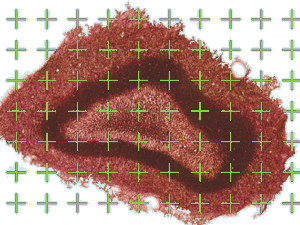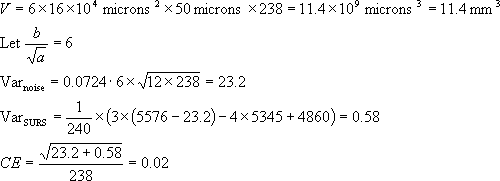The Cavalieri estimator is used to estimate volume. If you follow the rules you will arrive at an unbiased estimate of volume. The precision of sampling should also be considered. How many sections and how many points per section are needed? There are several ways to think about this (see precision), and come up with a starting point for a pilot study. The following is an example of a pilot study but the number of sections and number of points will depend on your material.
Begin by preparing a set of sections. The Cavalieri estimator is prone to overprojection if the set of slices are thick. The sections are sampled using the fractionator principle. A possible starting point for a pilot study might be 10 to 15 sections. Suppose that the tissue is sectioned into 80 sections. If every 6th section is used, then around 13 sections are used. The fraction of sections used is the section sampling fraction or ssf.
The Cavalieri estimator is usually performed using a point grid. The points need to be appropriately spaced. The points are usually spaced equally both across and down. With computer-assisted stereology it is very easy to mark points so don’t worry if you think you will be doing too much work because the points are too close together. Make the points dense enough to cover any bays, peninsulas and isthmuses in the tissue. Because the points don’t cost much work, the parameter to adjust to affect precision is the section interval.
 Figure 1. Point grid overlaid onto tissue.
Figure 1. Point grid overlaid onto tissue.
Toss the point probe randomly onto each section. Count how many points hit the region of interest. Keep a record of how many points hit each section. The results are used to compute the volume and the CE.
 Figure 2. CE estimation for point counting across sections.
Figure 2. CE estimation for point counting across sections.
The CE calculation requires the determination of the shape factor. The shape factor is defined as the boundary length divided by the square root of the profile area. The Cavalieri estimator has already estimated the profile area. The boundary length must now be estimated. The shape factor varies little between similar organs so once the shape factor has been determined the same value can be used in other Cavalieri estimators.
To make the formula easier to understand here is an example.
| Sampling Parameter | Value |
| Slice Interval | 6 |
| Grid spacing | 400 microns |
| Block advance | 50 microns |

Figure 3. Sampling fractions used in the example.
Here are the counts:
| Section | P | A | B | C |
| 1 | 6 | 36 | 66 | 96 |
| 2 | 11 | 121 | 176 | 242 |
| 3 | 16 | 256 | 352 | 336 |
| 4 | 22 | 484 | 462 | 594 |
| 5 | 21 | 441 | 567 | 525 |
| 6 | 27 | 729 | 675 | 837 |
| 7 | 25 | 625 | 775 | 800 |
| 8 | 31 | 961 | 992 | 775 |
| 9 | 32 | 1024 | 800 | 480 |
| 10 | 25 | 625 | 375 | 175 |
| 11 | 15 | 225 | 105 | |
| 12 | 7 | 49 | ||
| Totals | 238 | 5576 | 5345 | 4860 |

Figure 4. Volume estimate and CE estimate for the Cavalieri estimator.
The shape factor was assigned a value of 6 in this example. It is possible to assign a value from estimation or by inspection using a nomogram.
In summary the steps of the estimator are:
- Prepare a set of Cavalieri sections.
- Sample the sections with a fractionator.
- Select a spacing for the point probe.
- Randomly toss the point probe onto each section.
- Count how many points hit the region of interest.
- Process all sections keeping a tally of counts per section.
- Possibly estimate the shape factor.
Calculate the volume and the CE.
For more on Cavalieri/point-counting and volume estimation, please see ‘Volume‘.
REFERENCES
____________________________________________________________________

Sponsored by MBF Bioscience
developers of Stereo Investigator, the world’s most cited stereology system